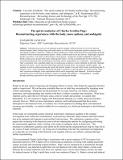| dc.contributor.author | Cavicchi, Elizabeth | |
| dc.date.accessioned | 2023-09-15T17:31:09Z | |
| dc.date.available | 2023-09-15T17:31:09Z | |
| dc.date.issued | 2011 | |
| dc.identifier.isbn | 9781905267484 | |
| dc.identifier.uri | https://hdl.handle.net/1721.1/152176 | |
| dc.description.abstract | Following discoveries of self-induction made by Faraday (1834) and Henry (1832/1835), Harvard medical student Charles Grafton Page took bodily shocks in 1836 from his homemade spiralled conductor while interrupting its battery connection. Unlike his famous predecessors, Page inserted connectors intermediate along the conductor which increased experimental options: shocks could be taken across any interval. Surprisingly, Page felt shocks everywhere, even where no direct battery current passed. Acupuncture needles amplified his sensitivity. Bodily contact across greater spiral spans yielded greater shocks. Having no interpretation for these effects, Page researched productively, later developing the instrument and its interpretations in a community. I reconstructed Page’s experiment with a spiralled copper foil, an oscilloscope as detector, resistor substitute for the body, flashlight batteries and switch. Across intervals where Page reported increased shock, I encountered variable signals. My methods evolved to include activating the spiral with periodic signals or my spur wheel switch, and picturing data by alterative views. These techniques functioned like Page’s connectors to open up options for further testing. Page and I experienced ambiguity in the experimental effects and in interpreting what happened. In both the original experiment and its reconstruction, productive means of working with ambiguity – not dispelling it—emerged through exploratory generation of new options for experimenting and thought. | en_US |
| dc.publisher | National Museums Scotland | en_US |
| dc.rights | Creative Commons Attribution-Noncommercial-Share Alike | en_US |
| dc.rights.uri | https://creativecommons.org/licenses/by-nc-sa/4.0/ | en_US |
| dc.source | Elizabeth Cavicchi | en_US |
| dc.title | The spiral conductor of Charles Grafton Page: Reconstructing experience with the body, more options, and ambiguity | en_US |
| dc.type | Book chapter | en_US |
| dc.identifier.citation | Cavicchi, Elizabeth. “The spiral conductor of Charles Grafton Page: Reconstructing experience with the body, more options, and ambiguity,” in K. Staubermann (Ed.), Reconstructions: Recreating Science and Technology of the Past (pp. 127-170). Edinburgh, UK: National Museums Scotland, 2011. | en_US |
| dc.contributor.department | Edgerton Center (Massachusetts Institute of Technology) | en_US |
| dc.contributor.approver | Elizabeth Cavicchi | en_US |
| dc.relation.journal | Reconstructions: Recreating Science and Technology of the Past | en_US |
| dc.eprint.version | Author's final manuscript | en_US |
| dc.type.uri | http://purl.org/eprint/type/BookItem | en_US |
| eprint.status | http://purl.org/eprint/status/PeerReviewed | en_US |
| dspace.date.submission | 2023-09-15T17:23:41Z | |
| mit.metadata.status | Authority Work and Publication Information Needed | en_US |
